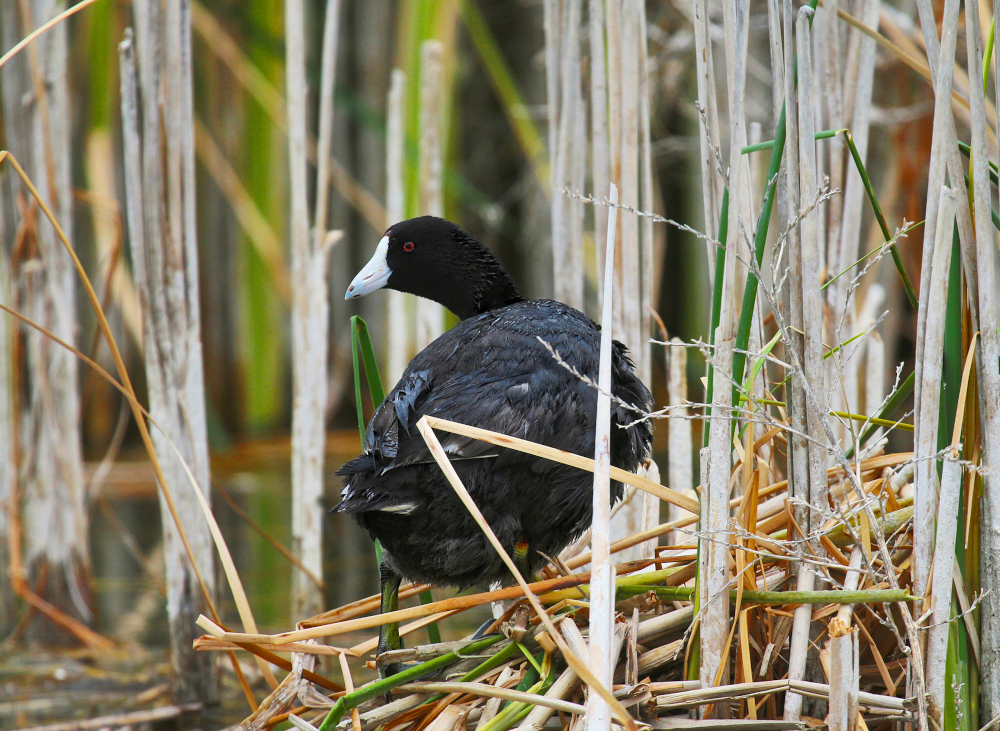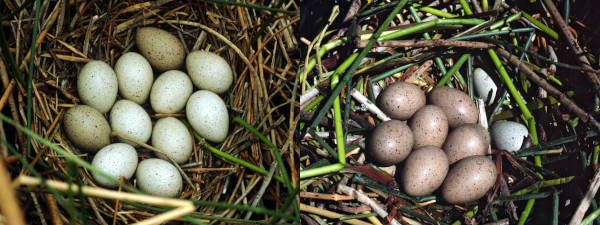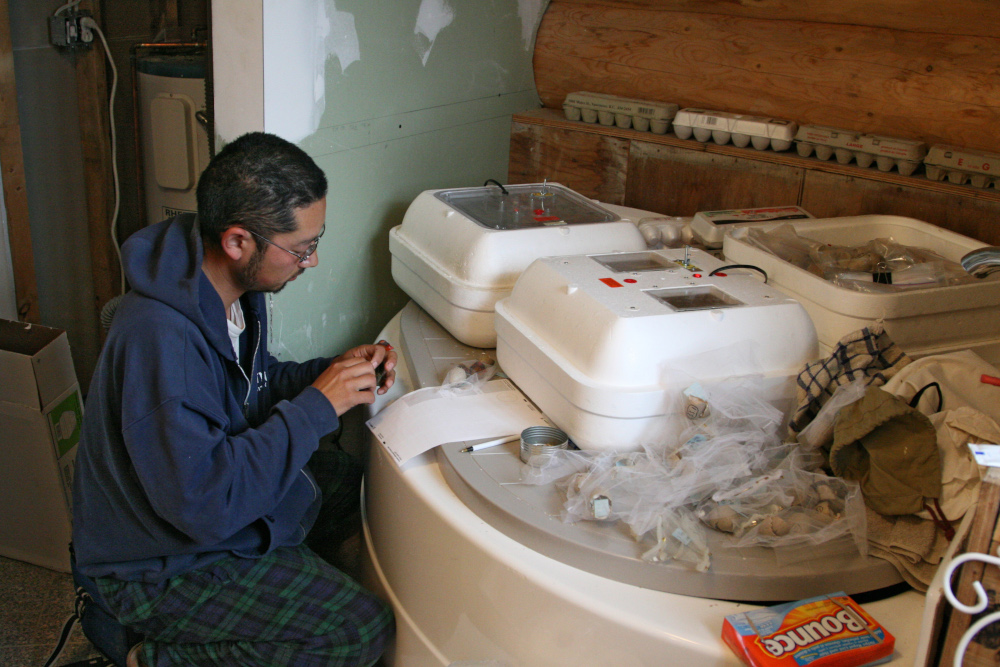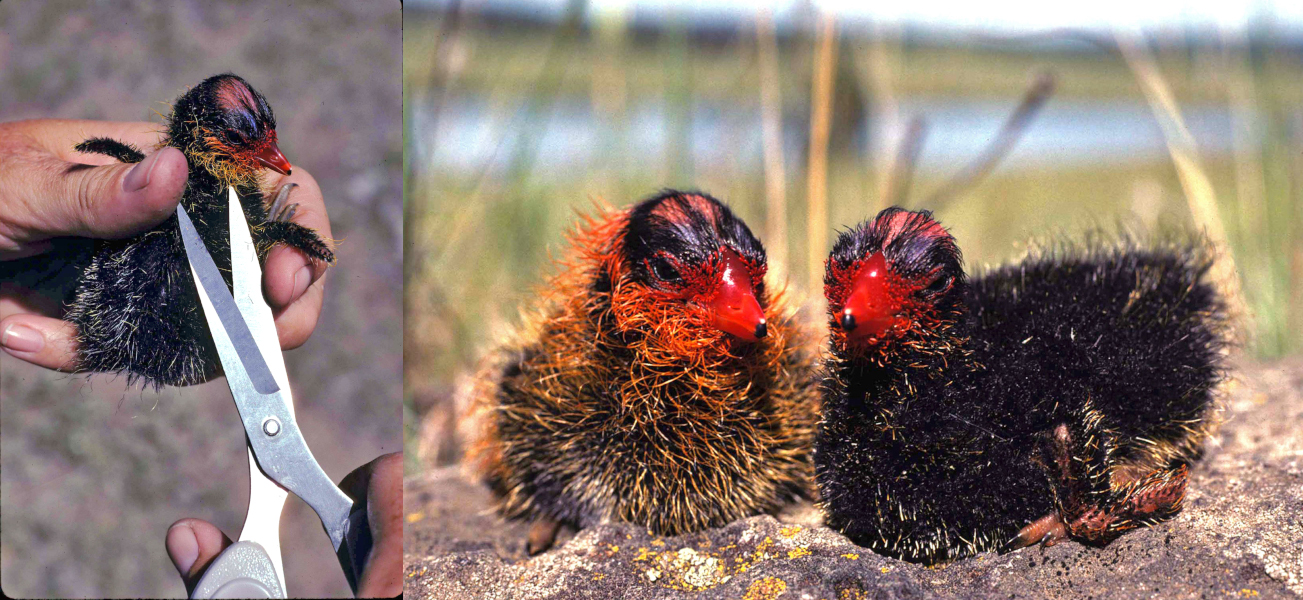
Birds do it
Putting your eggs in more than one basket
Slogging through Canada’s Riske Creek wetlands as a graduate student in 1987, Bruce Lyon noticed something odd in the nests of American coots. Early in the breeding season, some nests held extra eggs not quite resembling most of the rest. Furthermore, many parent birds had pushed those slightly different eggs aside.
It turns out that, in addition to—or instead of—laying eggs in their own nests, female coots sneak into their neighbors’ territories to lay eggs in their nests. Like the infamous cuckoos and cowbirds that evade parenting duties by laying their eggs in nests of other bird species, these ducklike fowl use a similar reproductive strategy, only they commit the offense against their own kind.
“I was so intrigued by this behavior,” said Lyon, now a UC Santa Cruz professor of ecology and evolutionary biology. “I thought it was bizarre that they were laying eggs in each other’s nests.”
For the next three decades, Lyon has worked to understand how and why coots lay some of their eggs in the nests of their fellow coots, a behavior formally called “conspecific brood parasitism.” Using coots as his primary model, Lyon aims to determine how this curious cheating by females—also seen in many other animals—might boost their reproductive success. In the bigger picture, the research is helping to explain the ecological and evolutionary basis for the development and persistence of such reproductive behaviors in the natural world.
Biologists have mostly focused on the peculiar strategies used by males within the same species to increase their reproductive success, like guarding mates and sneaky mating, i.e., dodging more dominant males to access females. The use of similarly complex tactics by females has received far less attention. “Males are more conspicuous and easier to study, while females usually play a bigger role at the nest and are more careful and secretive,” said Malte Andersson, an emeritus professor of animal ecology at the University of Gothenburg in Sweden. “There’s been a general underappreciation of the sophistication of female reproductive behaviors.”
In the coots he first observed as a graduate student, Lyon found a career-making opportunity to provide a better appreciation of one such sophisticated female reproductive behavior—the seemingly anomalous strategy of putting your eggs in more than one basket.
Hidden in plain sight
Observations of egg-dumping in same-species nests were not new. They go back to the start of the 20th century, with hunters and specimen collectors writing about occasional encounters with “misfit” eggs in waterfowl nests. On a hunting trip in 1900, for instance, Walter Sampson, found two kinds of eggs—nine somewhat darker and slightly larger than the remaining 12—in a wood duck’s nest in California. In 1922, Donald Dickey and Adriaan van Rossem counted additional new eggs on several days in a fulvous whistling duck nest in California, unusual because of the typical one-egg-a-day laying sequence in most birds.
While these reports were treated as freak cases at the time, we now know better. Lyon and other biologists have to date documented conspecific brood parasitism in 245 bird species—nearly two percent of all known birds. And several experts believe even more birds do it. The challenge to learning more about the behavior, however, comes from the difficulty of detecting it in the field. “It’s really hard to pick up,” said John Eadie, a Lyon collaborator and the Dennis G. Raveling professor in waterfowl biology at UC Davis. “The eggs of the same species can almost look the same. You have to do detailed, in-depth studies to really spot it.”

The eggs of different cliff swallows, for instance, are visually hard to distinguish. To confirm their nest parasitism behavior, researchers marked and tracked more than 200 eggs from 50 nests built by the colony-nesting birds. They also watched a few sneaky swallows laying eggs in their neighbors’ nests and even ferrying eggs in their beaks from their own nests to another’s when the neighbors were away. In American coots, moorhens, and several duck species, biologists have observed thousands of eggs each year to spot parasitism-linked extra eggs in nests that would otherwise house only a single new one every 24 hours. In some cases, differences in egg features are a giveaway. In others, researchers have needed genetic analysis to validate that a nest’s eggs belong to different females.
As the evidence has mounted, it’s become apparent that brood parasitism is most rampant among waterfowl—particularly ducks. Waterfowl have precocial chicks, meaning that the chicks are mobile and can quickly feed themselves, hatching at an advanced enough stage that parental care isn’t much needed. The increased prevalence in waterfowl makes sense, Eadie said, as “the cost of being parasitized is probably not very high when the kids are raising themselves.”
Recognize and reject
Although not waterfowl, American coots have semi-precocial chicks, which the parent birds feed for the first week or so. These dark-bodied, white-billed bird species live in the shallow waters of lakes, ponds, and marshes, nesting amid reeds in the spring and early summer.
With his survey of 417 nests between 1987 and 1990 in the wetlands of central British Columbia, Lyon was the first to document brood parasitism in coots. His monitoring of each nest at mostly daily intervals spotted the cheating when there were two or more new eggs within a 24-hour period, when egg color differed from that of the host’s eggs, and by finding extra eggs in the nest after the host had completed laying her clutch.

Even though coot pairs defend their territory aggressively during the breeding season, Lyon recorded three parasitic eggs, on average, in more than 40 percent of the nests—a substantial addition to a clutch otherwise including, on average, nine eggs. While a quarter of the parasitic eggs came from females with no nests at all, the majority came courtesy of neighboring coots—sometimes multiple females—with thriving nests.
Lyon also noticed that a third of the nearly 600 parasitic eggs he observed were buried under nesting materials the coots had stacked over them, raising the question of whether the birds were recognizing and rejecting them. Indeed, same as him, female coots could tell which of the eggs in their nests belonged to someone else. He confirmed this in a 2003 study, which showed the birds rejecting eggs with coloring different enough from that of their own. When they were uncertain, they banished potentially parasitic eggs to the periphery of their clutch—an inferior incubation position associated with delayed hatching; eggs hatching later pose less of a competitive threat to the bird’s true chicks.
Counting losses
Lyon found that coots also exhibit a remarkable ability to count their own eggs. Like many birds, American coots are indeterminate layers, meaning they use external cues such as number of eggs or their surface area to decide when to stop laying. If they couldn’t distinguish between parasitic eggs and their own, the final clutch would contain fewer host eggs. Instead, the coots who recognized parasitic eggs, and later rejected them, didn’t alter their egg laying. In contrast, the coots that couldn’t tell the eggs apart laid one less egg for every parasitic one in the nest.

Knowing that many parasitic eggs pass the rejection test, Lyon’s graduate student Daizaburo Shizuka (Ph.D. ‘09), now an associate professor of biological sciences at the University of Nebraska–Lincoln, wondered if the coots could further mitigate the costs of nest parasitism by discerning their own chicks.
In the nest, parasitic eggs—although deposited early by sneaky coots—typically hatch later amongst a brood that emerges over several days. In the field, Shizuka and Lyon documented more deaths of parasitic chicks than the hosts’ true chicks. This finding led them to suspect that the birds imprint on their own young that arrive early, using them as a template for recognizing the chicks that hatch later.
To test this hypothesis, Shizuka and Lyon conducted three cross-fostering experiments in wetlands of British Columbia between 2005 and 2008. They controlled the order in which the parents met their young after hatching by presenting them with either their own chick, a parasitic one, or both on the first day, followed by equal numbers of parasitic and true chicks over five subsequent days. Sure enough, the parents used the identity of the first provided chick, host or parasite, to discriminate against the other, which sometimes meant unleashing brutal aggression in the form of pecking and drowning to eliminate the unwelcome guests. “It was really non-random,” Shizuka said.
It gets more complicated. Parasitic chicks, although hatching later, usually come from the first few eggs laid by females before they begin laying in their own nests. These early eggs produce duller chicks—a consequence of laying order: chicks from eggs laid later sport ostentatious orange feathering. This means that the duller chicks must compete for food with the host’s younger, but showier, chicks born around the same time. At first, parents feed all their chicks on a first-come-first-served basis, but then the more ornamented orange offspring become their priority, and Shizuka and Lyon found that the flashiest chicks receive more food. In an earlier experiment, Lyon and colleagues compared orange chicks with dull ones whose colorful feathers had been experimentally trimmed, showing that the orange ones grew faster and had an increased chance of survival. Additionally, when older, duller offspring tried to steal food from their younger siblings, parent coots aggressively discouraged them. These findings all suggest that survival may be an uphill battle for parasitic chicks.
Why bother?
Despite the multiple lines of defense and extremely limited success in overcoming them, why do birds like American coots continue to make extra eggs and lay them in the nests of others of their own kind? It truly appears related to the old adage advising one to not put all one’s eggs in one basket. “Eggs are really cheap for coots,” Lyon said, and “babies are expensive.” In their own nests, females lay more eggs than they can raise because food availability is often unpredictable and limited. Starvation is a common cause of death among chicks. Given these capricious circumstances, “parasitism gives females a more flexible set of options to customize their reproductive effort,” Lyon said.

In nesting females, reproductive enhancement seems to be the likely motivation for parasitism. The total eggs produced by parasitic coots in British Columbia, for example, was greater than the clutch size of nonparasitic nesting coots. By laying eggs in someone else’s nest, the former might manage to have more successful offspring as compared to laying all eggs in their own nest. Some experts also think that if nests are preyed upon or destroyed, mothers may find another nest to lay their eggs in.
In the case of non-nesting females, on the other hand, lack of nesting sites or inability to defend territories could push them to make the best of a bad situation. Eadie, for instance, demonstrated elevated brood parasitism among cavity-nesting goldeneye ducks when he experimentally reduced the number of nest boxes available to them. In American coots, Lyon suspected that the female parasites without nests were younger or in poorer body condition compared to nesting birds, probably lacking the experience and fitness to secure a nest. “Their option is to sulk and lay no eggs or to lay some eggs elsewhere,” he said. Some have also wondered if non-nesting females might be professional, lifelong parasites, never making their own nests. But studies following such birds over multiple breeding seasons have shown that they resort to nesting at some point.
Long-term benefit
Unfortunately, female coots don’t return to the same nesting grounds year after year, so Lyon and his collaborators have been unable to track individuals to assess how often they parasitize others’ nests through their lifetimes, and thereby determine the behavior’s potential long-term reproductive benefit.
Female wood ducks are, however, loyal to their nesting spots. With Eadie, Lyon is studying nest-parasitising wood ducks tagged with trackers since 2014 that live in nest boxes in California. Among the questions they’re seeking to answer is when and why these fowl switch between laying eggs only in their own nests and additionally in their neighbor’s.

While he’s partial to birds, Lyon’s interest in reproductive parasitism extends to other creatures. Along with UCSC colleagues, Lyon recently reported an unusual case of potential brood parasitism in the nests of two damselfish species that spawn in the coral reefs of Philippine’s Calamian Archipelago. These fish appear to foster the young of other adults of their own kind as well as those of another species, all while taking care of their own.
The work is difficult, typically requiring years of painstaking field observation and, increasingly, the use of sophisticated methods such as genetic analyses. But for Lyon, the reward comes from helping to illuminate a previously poorly explored part of nature. “We’re taking this behavior that was neglected, seen as unimportant and kind-of flaky, and connecting it to species’ life histories,” he said. “There are books about alternative mating strategies where it’s all about males, with almost zero focus on females. My research shows the value of taking another look.”

